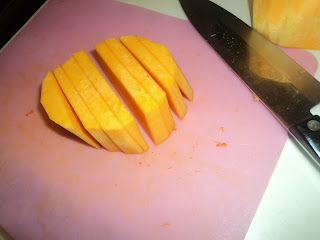The idea is to put all the “annoying” ingredients together into a gelatin which is served as a baby food; the remaining ingredients – water, lactose, milk, cream, whey – make a lovely milk to be fed in bottles, sweet and creamy. And it doesn't curdle or separate. Together, the solids and liquids have exactly the same amounts of the same ingredients as the wapf raw milk formula, except there is ¼ cup more water and 1 tsp less gelatin. Use only when baby is ready to have solids several times a day, so that the baby gets all the nutrition that was in a batch of the WAPF formula.
The solid part is not exactly tasty, but it makes a fantastic base for introducing every other baby food - bananas, squash, carrots, broth, ripe peaches, applesauce, yogurt, etc. (we do GAPS so no sweet potatoes). I've found it very, very convenient to have on hand and she just loves her food!
Solids (Baby food)The solid part is not exactly tasty, but it makes a fantastic base for introducing every other baby food - bananas, squash, carrots, broth, ripe peaches, applesauce, yogurt, etc. (we do GAPS so no sweet potatoes). I've found it very, very convenient to have on hand and she just loves her food!
1/4 cup filtered water
1 teaspoon gelatin
Sprinkle gelatin onto water in a small saucepan and dissolve on low heat until liquid is clear (doesn't take long because there's so little water). Turn off heat. Cool down (place saucepan in a pan of cold tap water for a 10-20 seconds, or make the liquids in the meantime) until still warm enough to melt the high vitamin butter oil and coconut oil, but not hot.
Add:
¼ teaspoon high-vitamin butter oil
2 teaspoons coconut oil
1 teaspoon expeller-expressed sunflower oil
1 teaspoon extra virgin olive oil
½ teaspoon fermented cod liver oil
2 teaspoons Frontier brand nutritional yeast flakes
¼ teaspoon acerola powder
Make sure the temperature is below 105 F before adding:
¼ teaspoon bifidobacterium infantis
1 egg yolk (optional)
Add:
¼ teaspoon high-vitamin butter oil
2 teaspoons coconut oil
1 teaspoon expeller-expressed sunflower oil
1 teaspoon extra virgin olive oil
½ teaspoon fermented cod liver oil
2 teaspoons Frontier brand nutritional yeast flakes
¼ teaspoon acerola powder
Make sure the temperature is below 105 F before adding:
¼ teaspoon bifidobacterium infantis
1 egg yolk (optional)
 Stir with a whisk until well mixed. Pour into a baby food jar. Refrigerate. When it’s gelled, to serve to baby, mash about one third of the gel with a piece of banana in a baby food mill (type pictured here), or ripe peach, cooked squash or carrots, yogurt, etc. Use at same rate as the liquid.
Stir with a whisk until well mixed. Pour into a baby food jar. Refrigerate. When it’s gelled, to serve to baby, mash about one third of the gel with a piece of banana in a baby food mill (type pictured here), or ripe peach, cooked squash or carrots, yogurt, etc. Use at same rate as the liquid. Liquids (Bottles)
"Lactose water": Dissolve ¼ cup lactose in 7/8 cup water over medium heat. When the liquid is clear (doesn’t take as long as in the original formula with the gelatin), turn off heat, add 1 cup water. Pour into a glass container for storage. When it cools enough not to kill the probiotis in the whey, add and 1/4 cup whey. Keep refrigerated. Makes 2 and 1/8 cups.
"Creamy milk": In another glass container, mix the 2 cups farmer’s milk and 2 Tablespoons (or more) cream (use a wire whisk or immersion blender). Makes 2 and 1/8 cups.
To serve, mix equal parts lactose water and creamy milk in a baby bottle. Warm if desired.
You should run out of the lactose water, creamy milk, and baby food gelatin at the same time or nearly so.
If you store the liquids in the same type of bottle, it's easy to keep the quantities in them equal so you run out of them at the same time.
If you store the liquids in the same type of bottle, it's easy to keep the quantities in them equal so you run out of them at the same time.







